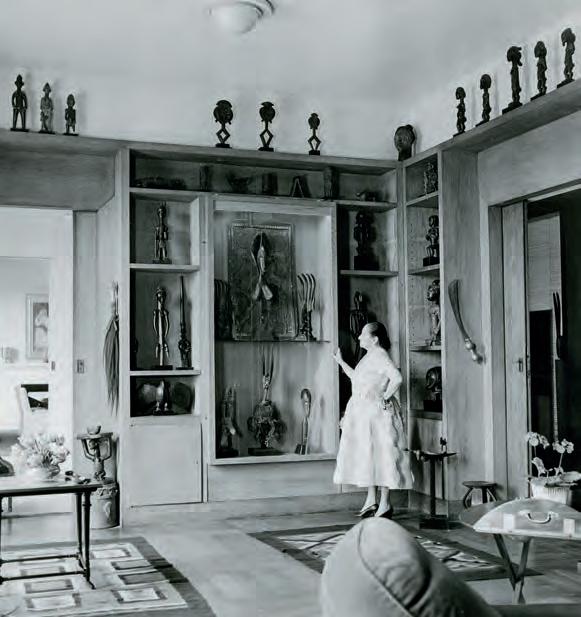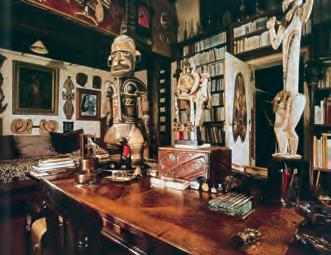
7 minute read
Vanguardia, coleccionismo y exposiciones de arte no occidental
Vanguardia, coleccionismo y exposiciones de arte no occidental
Avant-garde, Collection and Display of non-Western art
Advertisement
Desde finales del siglo XIX, bajo el dominio colonial, una enorme cantidad de artefactos de África, Asia, América y Oceanía fueron desplazados de sus lugares de origen a los museos y colecciones privadas de Europa. En los nacientes museos etnográficos y de historia natural, estos objetos eran presentados en vitrinas abigarradas, descontextualizados, y sin información sobre su procedencia, historia, función o valor. Este desconocimiento contribuía a perpetuar el halo de misterio asociado a los mismos. Esta fascinación hizo que los artistas de las primeras vanguardias les otorgaran un carácter de fetiche y empezaran a interesarse por ellos, haciendo que su supuesta otredad contaminara simbólicamente sus propias obras. En los talleres de artistas como Pablo Picasso, André Derain, Emil Nolde o Ernst Kirchner, estas esculturas de arte negro, “primitivo” o tribal convivían e inspiraban formalmente sus propias obras. Este fenómeno se ha convertido en un mito de origen del arte moderno y sólo en los últimos años ha sido revisado desde un punto de vista crítico.
El interés por desafiar el arte tradicional burgués y consolidar las nuevas formas artísticas hizo que esta identificación entre arte “primitivo” y vanguardia se extendiera y se organizasen exposiciones en Alemania, la República Checa y Estados Unidos donde
Starting in the late 19th century, an enormous quantity of artefacts from colonial Africa, Asia, the Americas and Oceania were removed from their original contexts and ended up in European museums and private collections. At the fledgling museums of ethnography and natural history, these objects were displayed in cluttered vitrines, taken out of context and with no information on their provenance, history, purpose or value. The absence of background information enhanced the aura of mystery surrounding these exotic imports, which so fascinated avant-garde artists that they began to view them as fetishes, icons of a supposed otherness that symbolically tinged their own works. In the studios of Pablo Picasso, André Derain, Emil Nolde, Ernst Kirchner and other artists, sculptures of black, “primitive” or tribal art shared space with and formally inspired their creations. This phenomenon gave rise to a myth about the birth of modern art which has only been critically revisited in recent years.
The interest in defying traditional bourgeois art conventions and consolidating new creative forms popularized this association between “primitive” and avant-garde art, and the two art forms were displayed jointly at exhibitions in Germany, the Czech
se presentaban ambas producciones de forma conjunta. La creciente visibilidad y éxito de estas piezas hizo que surgieran marchantes especializados, como Alfred Stieglitz, Paul Guillaume o Charles Ratton, y pronto se desarrolló un mercado para abastecer a coleccionistas privados y afianzar el gusto de una burguesía deseosa de ser moderna. Entre otras muchas colecciones de la época, destacan las de Albert Barnes, André Breton, Nell Walden, Carl Kjersmeier, los Arensberg, los Rockefeller, Peggy Guggenheim o Helena Rubinstein. La disposición conjunta de las obras en sus casas, frecuentemente fotografiadas por las revistas de moda, difundió uno de los imaginarios más reconocibles de los dispositivos de exposición de entreguerras. Poco después, algunos museos como el MoMA institucionalizaron esta práctica mediante la organización de una serie de muestras donde se fomentaba una valoración exclusivamente estética de estos artefactos. Al presentarse de forma individualizada, sin información contextual y realzando sus aspectos formales, las exposiciones resignificaban estas obras y generaban un discurso que ocultaba las condiciones coloniales que habían hecho posible su llegada y las interpretaba desde un marco estético y epistemológico de naturaleza eurocéntrica.
Republic and the United States. As such pieces became increasingly visible and popular, dealers like Alfred Stieglitz, Paul Guillaume and Charles Ratton specialized in the genre and a flourishing market soon emerged to supply private collectors and cater for the whims of a middle class eager to “be modern”. Some of the most notable collections of the period were assembled by Albert Barnes, André Breton, Nell Walden, Carl Kjersmeier, the Arensbergs, the Rockefellers, Peggy Guggenheim and Helena Rubinstein. The indiscriminate arrangement of these pieces in their homes, frequently photographed for fashion magazines, became one of the most common and familiar display devices of the interwar years. Soon afterwards, the MoMA and other museums institutionalized this practice by organizing shows that promoted a strictly aesthetic appreciation of these artefacts. By presenting them as solitary, decontextualized objects and emphasizing their formal aspects, the exhibitions resignified these works and generated a discourse that obviated the colonial conditions under which they had entered the museum and interpreted them from a Eurocentric aesthetic and epistemological perspective.

Max Ernst im Stadthaus von Peggy Guggenheim [Max Ernst en la casa de Peggy Guggenheim / Max Ernst at Peggy Guggenheim’s home], 1942

Los estudios de Sigmund Freud y André Breton / Sigmund Freud and André Breton’s Studios
Edmund Engelman Berggasse 19: Sigmund Freud’s Home and Offices, Vienna 1938 [Berggasse 19: Casa y oficinas de Sigmund Freud, Viena 1938] . Nueva York, Basic Books, 1976
Julien Gracq 42 rue Fontaine. L’atelier d’André Breton [42 rue Fontaine. El estudio de André Breton]. París, Adam Biro, 2003
Las colecciones de Sigmund Freud y André Breton generaron ambientes singulares que fueron recogidos en algunos proyectos fotográficos que contribuyeron a guardar la memoria de los mismos. En el caso de Freud, el reportaje fue encomendado por su colega, August Aichhorn, a Edmund Engelman, que realizó más de 100 fotografías en la Berggasse 19 a lo largo de cuatro jornadas, unos días antes de la huida del psicoanalista y su familia desde Viena hacia Londres. El encargo fue hecho a Engelman, un ingeniero con estudios de química que regentaba una tienda de fotografías, porque tenía los conocimientos técnicos suficientes para hacer las fotos con poca luz sin llamar la atención de la Gestapo, que tenía vigilada la casa desde la anexión de Austria por parte de los nazis. Con el traslado a Londres, su estudio fue recompuesto en el 20 de Maresfield Gardens, casa donde éste vivió el último año de su vida y actual Freud Museum. Las fotografías constituyen un documento único del espacio en el que Freud trabajó durante 47 años. Sin embargo, el proyecto no vio la luz pública hasta 1976, año en que una parte de las fotografías fueron publicadas por una editorial de Nueva York, ciudad a la que emigró el propio Engelman unos meses después de Freud.
The collections of Sigmund Freud and André Breton created singular atmospheres that were documented in photographic reports to preserve their memory. Freud’s colleague August Aichhorn invited Edmund Engelman to photograph the doctor’s home and workplace at Berggasse 19. Over the course of four days Engelman snapped more than one hundred photographs, just before the psychoanalyst fled from Vienna to London with his family. The job was given to Engelman, an engineer who had studied chemistry and ran a photo studio, because he had the technical knowledge needed to work in poor light without attracting attention from the Gestapo, who had been watching the house since the Nazis annexed Austria. After moving to London, Freud reassembled his workspace at 20 Maresfield Gardens, the house where he spent the last year of his life and current home of the Freud Museum. Engelman’s photographs are the only visual record of the space where Freud worked for forty-seven years. However, the images were not made public until 1976, when some of the photos were released by a publishing house in New York, the city to which Engelman immigrated a few months after Freud’s departure.
Julien Gracq
El reportaje de Gilles Ehrmann fue encargado tras la muerte de Breton en 1966 por su viuda Elisa con el fin de realizar un inventario de su estudio. Ehrmann trabajó dentro del marco de la fotografía documental de posguerra y su obra se caracterizaba por una sensibilidad cercana al surrealismo. Amigo de Breton, con el que había realizado algunas publicaciones, puso su mirada a disposición de este proyecto memorialístico y realizó 14 Ektachromes. El material permaneció inédito durante 30 años y 10 de las fotografías fueron publicadas en una edición de bibliógrafo en 1997, ilustrando un texto del escritor Julien Gracq. El libro fue republicado en 2003, año de la subasta y dispersión definitiva del estudio de Breton.

After Breton’s death in 1966, his widow Elisa needed to inventory the contents of his studio and hired Gilles Ehrmann to do a photographic report. Ehrmann worked in the field of postwar documentary photography and had a special sensibility close to Surrealism. He and Breton were friends and had produced several publications together, so when Elisa called he willingly accepted this commemorative commission and took fourteen Ektachromes. The prints remained unpublished for thirty years until 1997, when ten of the photographs were used to illustrate a text by the writer Julien Gracq. A reprint of the book appeared in 2003, the year in which Breton’s studio collection was sold at auction and broken up for good.











